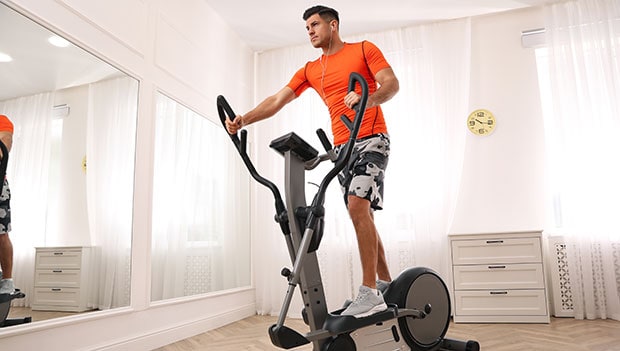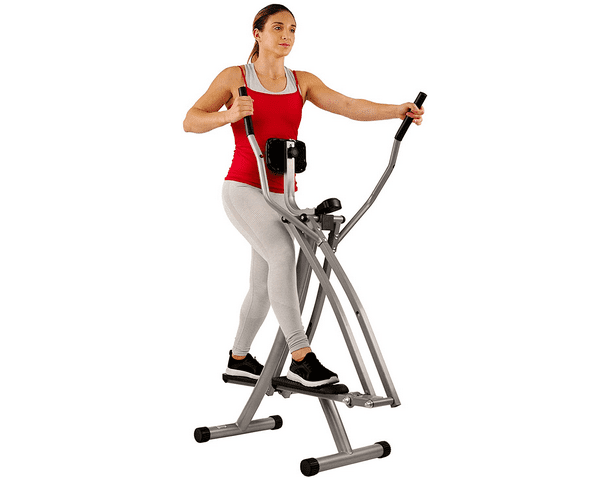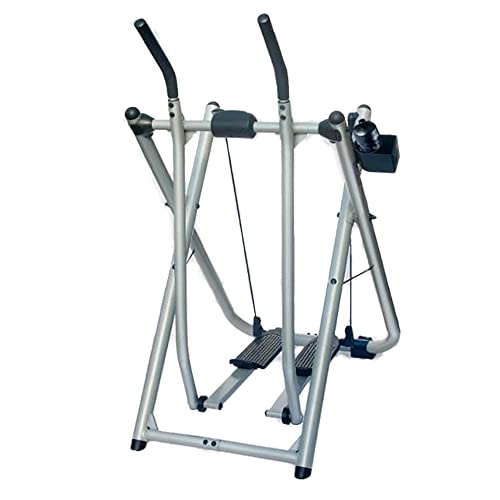Elliptical Machine vs Glider – Which Should You Choose?
If you’re looking for a piece of gym equipment that can provide a low-impact, aerobic workout, you may have come across the glider as a possible alternative to the elliptical. But how do these machines differ and which should you spend money on?
In brief, glider machines can be a good option for people looking for a budget-friendly, accessible cardio workout from the comfort of their own home.
They can also be an attractive choice for people who are just getting into personal fitness and looking to increase their fitness and mobility gradually.
However, those looking for a more intense or scaleable workout may find that an elliptical trainer offers them greater range and a more satisfying physical challenge.
Ready to start your elliptical weight loss journey? Try out our 8-week elliptical program!

Today, we’re going to be looking in more detail at some of the main differences between the glider and the elliptical machine, as well as some of the pros and cons of each.
If you’re looking to introduce a new piece of aerobic kit into your home fitness set-up, or are looking to experiment with a new machine down the local gym, we’ll be thinking today about what ellipticals vs gliders have to offer.
Are Gliders and Elliptical Machines The Same?
Gliders and elliptical machines are both designed to provide users with a low-impact aerobic workout which puts less strain on the lower limbs and joints.
This can make both machines an attractive option for people recovering from injuries or for those who find other, traditional aerobic workouts such as running or athletic sports uncomfortable.
However, gliding machines, sometimes called air gliders, have a slightly different range of movement to the more widely used elliptical. With an air glider, your legs tend to remain relatively straight and your knees flex less. The range of motion is roughly that of a shallow arc.
With an elliptical, however, your feet move via the foot pedals in a circular, elliptical motion, with greater flexion in the knees.

This more closely mimics the action of running or walking, though without the impact on the floor that both these forms of movement involve.
Both air gliders and elliptical machines provide cardio workouts. They are designed primarily with cardio fitness and weight loss in mind, rather than body building or muscle expansion.
Although manufacturers of both machines are likely to point towards their muscle strengthening qualities, you’re unlikely to be able to build significant muscle mass using either of them in isolation.
They can, however, both be used as part of a healthy diet and general fitness routine to burn calories, lose weight, and help tone or maintain muscles in the lower body.
The use of handles and arm levers can also work aspects of the upper body, though not as effectively as a targeted weight training or upper body strengthening routine.
Which is Better – Elliptical Machine or Gazelle?
The Gazelle glider is one of the most popular air gliders on the market. The company has been producing home workout equipment for more than 20 years and aims to provide users of differing fitness with affordable home gym solutions
How does the Gazelle glider differ from an elliptical machine? To begin with, Gazelle gliders have a much wider stride, with the potential for users to stretch their legs further apart than with the vast majority of elliptical machines.
Furthermore, the range of motion with the Gazelle, as with most gliders, is of a shallow arc that involves the legs remaining relatively straight. With elliptical machines, the feet travel through a circular, elliptical shape that is more similar to running or walking.

Whether or not the Gazelle gliders’ range of motion suits you more comfortably than the elliptical will depend on your own physical needs and preference.
Some people with mobility or joint issues may find the comparatively ‘straight’ motion of the Gazelle preferable. However, the potential to overstretch on the Gazelle is also greater than with the elliptical, where the range of motion is often determined prior to the commencement of your workout.
The makers of the Gazelle point towards its versatility as a workout tool, with different muscle groups becoming activated via different postures and approaches from the user.
If you lean forward on the Gazelle, it is said to target your chest and upper body muscles. Leaning back engages your hamstrings and glutes more heavily. It is also claimed that lifting your heels during the workout allows you to target your calves.
However, the range of resistance offered by most elliptical machines is likely to outstrip the Gazelle. This is a crucial difference for many workout enthusiasts, a number of whom report feeling underwhelmed and underworked by the limited resistance offered by the Gazelle.
Although it is possible to equip your Gazelle with hydraulic ‘power pistons’ that offer different bands of resistance, the range of different pressures and gradients is still likely to be limited compared to the adjustable scale of most ellipticals.
Here is my personal favourite glider:
- Tighten and tone every major muscle group in your body with this fitness machine that is ideal for home workouts; Weight limit: 300 pounds
- Includes 10 individualized exercises in this calorie-burning piece of workout equipment; Includes exercise manual and water bottle
- Patented, dual-action split suspension provides a complete range of motion to ensure your properly working your muscles; Built with extra wide foot platforms for stability and foam handlebars for comfort
Last update on 2024-07-26 / Affiliate links / Images from Amazon Product Advertising API
Elliptical Glider vs Cross Trainer
The greater range of resistance commonly offered by traditional cross trainers when compared to gliders is potentially one of the biggest factors to consider when choosing your new piece of kit.
Those looking for a scalable workout, or those looking to make significant gains in the level of intensity and energy expended during their workouts over time, may find that the comparatively limited range of resistance offered by most gliders to be a frustrating ceiling.
Indeed, gliders are commonly seen as being a good option for people who may be starting from a relatively low fitness threshold, or for people looking to reintroduce workouts into their daily lives after a long period of inactivity or injury recovery.
For people who are already quite fit and looking for a machine that can push their limits, gliders may prove to be too limited in the levels of ‘difficulty’ they can offer.
Some users point towards the relatively low resistance as being a positive feature of the glider, claiming that this allows for longer periods of elevated heart rate without the risk of suffering from muscle fatigue.
If you require a machine that will get the heart pumping and the lungs working, but with minimum strain on the lower body and joints, the glider could be a good option. The pace and function of the machine are largely driven by the user’s own movement and momentum.
Therefore, it allows less confident gym users to start their workouts at a level that is manageable for them.
Higher end ellipticals are likely to feel far more stable and durable than their lighter, gliding counterparts. Indeed, one of the downsides of the glider is that heavier users, or those who have difficulties balancing, may find that the lightweight frame and comparatively thin attachments on most gliders feel a little unsteady during operation.
This is my go to high end elliptical the will last a lifetime:
- Goal Track capability enables users to set individual exercise goals by tracking time, distance and calories to compare with previous workouts
- 20 inch stride with Precision Path foot motion technology simulates a natural running motion
- High speed, high inertia drive system offers easy start-up and smooth, quiet workouts
Last update on 2024-07-26 / Affiliate links / Images from Amazon Product Advertising API
Although manufacturers of both machines will claim that they are well suited to High Intensity Interval Training (HIIT), it is probably the case that the greater range of resistance offered by cross trainers makes them more suited for HIIT workouts.
HIIT sessions involve interspersing periods of high exertion with periods of comparative rest. Higher end elliptical trainers are often equipped with the ability to switch resistance levels at the touch of a button, or with the potential for programmable workouts.
This is another marked difference between upmarket ellipticals and the majority of glider machines. The latter, including the popular Gazelle, come with basic computer functions that are really only used to measure simple workout statistics, such as time and ‘steps’ taken.
Elliptical machines enjoy a far broader market, with higher end models boasting more complex computer systems and high-tech LCD screens. This, along with their greater range of resistance, can offer customers a more flexible, programmable workout experience than the comparatively limited gliders.
Which Burns More Calories – Elliptical or Glider?
The main caveat that comes with any answer as to which machine burns more calories is that this largely depends on how you use them! Both machines come with the potential to be operated more or less ‘intensely’, simply by users pushing harder or ramping up the resistance.
This, along with length of workout and the weight of the user, will all go into determining the number of calories burned during a session.
However, as a general rule, it would seem that elliptical machines overall are likely to burn more calories per minute than a comparable workout on the glider.
Estimates for a 30 minute, moderate intensity elliptical session come in at slightly above 300 calories (for someone weighing roughly 150 lbs).
Estimates for glider calories are not as easy to come by, simply because the machines are less widely used and less established as part of professional gym set ups.
However, the manufacturer of the Gazelle estimates that a workout of around 30 minutes for a 150 lbs user is in the region of 250 calories.
What Costs More – Glider or Elliptical?
This is another primary difference between the two types of machine, and a deciding factor for many who may be considering buying one for the home.
Elliptical machines are manufactured by a range of companies and have been designed for a range of budgets. However, a mid-range, dependable model is likely to cost you upwards of $600 at least.
Premium or gym-grade models can easily climb above $1500. As a general rule, the more expensive the machine, the more durable, dependable, and smooth the workouts it provides are going to be.
Gliders, on the other hand, are frequently marketed as being more budget-friendly options. Rather than being seen as equipment for fitness enthusiasts or dedicated home-gym builders, many glider manufacturers sell their machines as accessible, affordable pieces of kit for people who just want to be a bit more active.
Their target customer base tends to be people looking to start their personal fitness journey, or those looking for a casual, accessible way of boosting their cardio-vascular health from the comfort of their living room.
As such, gliders are often far more affordable than many elliptical machines. The most expensive Gazelle model is less than $300. Other glider machines come with price tags between $150 and $300.
Final thoughts
If you’re looking for a low impact, low cost cardio workout and are not necessarily too concerned with being able to ramp up the resistance on your sessions, an air glider might provide an ideal, affordable piece of kit to introduce into your home.
They also tend to be more compact than larger elliptical models, with many gliders capable of being folded away and tucked under a bed.
On the other hand, fitness enthusiasts or regular gym goers looking for a low-impact but still challenging workout may find the glider to be limited in what it can offer.
The elliptical, a more established and traditional piece of gym equipment, is likely to offer more range of resistance, as well as a wider range of potential features, than its air gliding counterpart.
An ex-triathlete, fitness coach and writer with a Masters in Sports Physiology. Fitness is my passion and I've had my fair share of home fitness equipment tried and tested!






